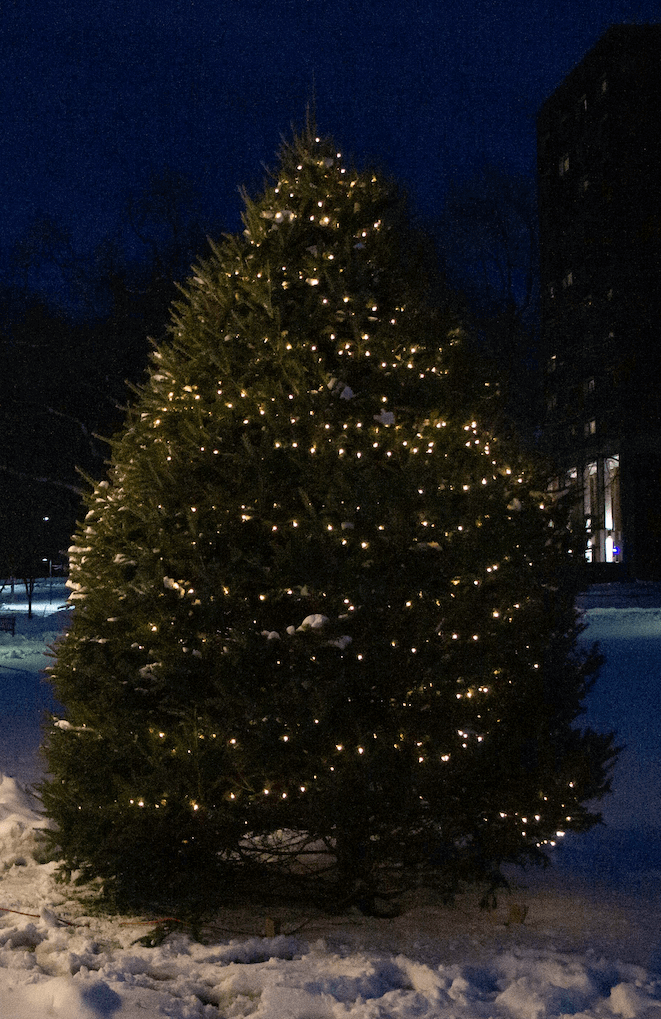by Kaelin Ferland '23 on December 8, 2022
Opinion Staff
Eco Updates

I love Christmas, but I also love the planet. I won’t be the Grinch and take away your wrapping paper and plastic trees, but it’s important to consider the environmental impact of this holiday so that we can celebrate in a way that is more sustainable and less harmful to our planet.
One way that you can minimize your environmental impact this year is by rethinking gift wrapping. According to Biffa, one of the United Kingdom’s most prominent waste management companies, 277,000 miles of wrapping paper are thrown out every holiday season in the UK alone. Considering that the US population is about five times the size of the UK’s, the amount of wrapping paper wasted in the US is likely much higher.
A substantial number of trees is required to produce this much paper. Deforestation not only decreases biodiversity and takes away important habitats from species, but it also impedes our planet’s natural ability to mitigate climate change. This is because trees naturally remove carbon dioxide from the air for photosynthesis. According to a 2021 study in the scientific journal Nature, some sections of the Amazon Rainforest, which once served as an important absorber of carbon dioxide, have been releasing more carbon dioxide than they absorb due to deforestation. This has major implications for climate change.
Instead of traditional wrapping paper, try reusing the same wrapping paper each year. Saving and reusing the gift bags and tissue paper that you acquire throughout the year is also a great alternative. You can even use brown paper bags that you get from stores as wrapping paper and add some decorative twine to give it a more natural look. The Cowl you’re holding can also be a great alternative (especially if you use its festive front page). Instead of using regular plastic tape, use washi tape, as it is made from natural materials and can be recycled along with your repurposed wrapping paper. If you’re set on using ribbons and bows, keep reusing them year after year rather than disposing of them after one use. Sustainable gift wrapping doesn’t have to be ugly.
Trees are also obviously a huge part of Christmas, and there’s always the question of whether real or fake trees are better for the planet. The surprising answer is that real trees are more environmentally friendly. According to the Nature Conservancy, 10 million fake trees are purchased every year, with 90% of them being transported long distances from China to locations all around the world. This results in a significant amount of carbon dioxide emissions associated with shipping and transportation. This doesn’t even take into account the energy and emissions from artificial tree production.
The Nature Conservancy adds that in the US, there are up to 500 million trees for sale on farms. Of these trees, only about 30 million will be bought and used for the holiday season. This leaves a significant number of trees left over to be used as a habitat by many different organisms. The remaining trees will also be able to absorb carbon dioxide for the rest of the year. For the trees that are cut down, farmers will continue planting seeds in place of those trees. When you’re done with your real tree, they can also be recycled, while artificial trees cannot.
During the holiday season, we see a sharp increase in electricity use because of Christmas lights. In a 2008 report from the US Department of Energy, 6.6 billion kilowatt hours of electricity are consumed every year for holiday lights alone. The Center for Global Development states that this is more energy than countries including El Salvador and Ethiopia use in one year. Energy use is harmful to our planet because electricity relies on fossil fuels. According to the US Energy Information Administration, in 2021, 61% of electricity consumed was generated from fossil fuels. When we burn fossil fuels like coal and oil to produce electricity, this releases greenhouse gasses which cause global warming. We should try to decrease our energy and electricity use to help mitigate climate change. Also, think of how many times you’ve taken your Christmas lights out of storage, plugged them in, and they don’t work. Buying new lights and throwing out the old ones only adds to this waste.
To help decrease the amount of energy used for holiday lighting, try looking for LED or energy efficient string lights and light bulbs. Traditional bulbs waste 90% of their energy creating heat, while only the remaining 10% is actually used to produce light. LEDs are also much more reliable and durable than traditional lights, meaning that you’ll avoid that yearly frustration when your lights don’t turn on. Additionally, you can put your lights and candles on a timer so that they aren’t on long after midnight when everyone’s asleep. This also means you won’t forget to turn them off and waste energy.
Having a sustainable Christmas doesn’t mean sacrificing your favorite traditions, but by making small changes, you can make the planet merrier.